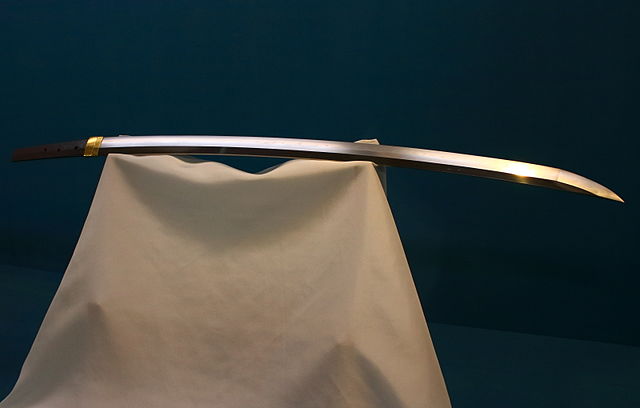
Why are katana blades curved? They are curved to make them more efficient at cutting.
Katana are long, curved swords from Japan. Their name “katana” means one-sided blade. “Kata” means “side” and “na” means blade. Many swords are double-sided because it allows them to be more effective when thrust. They can also be used to cut without worrying about which side is up. However, they aren’t as effective at cutting and they are more likely to break because a single-edged sword has a thick supporting spine.
There are many theorized reasons why the sword is curved, but it isn’t actually as curved as people think. The swords are between 60 to 73 cm long and they have an overall curve of about 1.5 cm. The curve is known as sori, which means warp, and it is measured by making a line from the tip of the sword to the hilt, and measuring the distance at the greatest point of the curve. And a 1.5 cm curve is not a lot when compared to some other swords, such as the scimitar from the Middle East.
So, why are katana blades curved? The first reason given is that a curved blade is much more effective for cutting. This is also the reason why the scimitar is so curved. This can be broken down into two parts. There is the way that the blade moves when it is used and the way that the blade intersects with the thing it is.
A curved blade is thought to be better for using from horseback. The curvature of the blade matches the movement of the arm and creates more power in the cut. It is also less wieldy to use on horseback and can be pulled back upright more easily. It has a lower center of balance. A curved sword is also less likely to get stuck in the thing (or person) being cut. The samurai were very skilled on horseback and were trained in the bow and the sword.
Then there is the idea that the curved blade increases the cutting power of the sword. The idea here is that the curvature of the blade means that less of the blade touches the thing being cut, which puts the same force along a smaller surface area, increasing its cutting power. This is theoretically true, but the katana doesn’t have enough of a curve to actually make any real difference. It takes an extremely curved sword like the scimitar for the curve to make any difference.
Another reason given is that the curve makes it easier to draw the sword from its sheath. Again, this is partly true, but there isn’t enough curve on a katana to really make much of a difference. The Mongols were famous for being a horse riding army and they used a very curved sword.
So, why are katana blades curved? It comes down to the way that they are made. The process starts by using a type of steel called tamahagane. This has many layers, each with different carbon properties. The steel is folded several times and then drawn out into a bar. The bar is hammered out into the sword shape and at this point it is a straight sword. The curve comes because of the way that the metal is hardened. Steel is hardened by being heated to a high temperature and then rapidly cooled by being plunged into cold water. When steel is heated to 750°C, it changes to austenite. This is where the steel is soft and its internal structure changes. If the austenite is cooled very rapidly in water, it becomes martensite, which is a very hard steel. The austenite is cooled so quickly that the carbon atoms get stuck in the internal structure and supersaturate it, making it stronger. If the austenite is cooled slowly, the carbon has enough time to move out and it becomes a softer metal. And this is the reason for the curvature in a katana.
The swordsmith covers the blade in a mixture of clay, water, and ash before heating it. The spine of the blade has a thick coating and the blade has a thinner coating. The heated blade is plunged into water and the blade is rapidly cooled because it only has a thin coating of clay, while the spine cools more slowly. This makes the blade extremely hard and the spine softer, allowing the spine to shrink while the blade expands and hardens. And this curves the sword. This manufacturing process results in very sharp and very strong swords, which also happen to be curved.
So, why are katana blades curved? Because it makes them stronger and sharper. The only reasons are probably not significant. And this is what I learned today.
Sources
https://en.wikipedia.org/wiki/Katana
https://en.wikipedia.org/wiki/Martensite
https://en.wikipedia.org/wiki/Austenite
https://medievalswordsworld.com/why-are-katanas-curved/
https://www.sword-buyers-guide.com/sori.html
https://www.martialartswords.com/blogs/articles/why-some-swords-have-two-edges-instead-of-one
